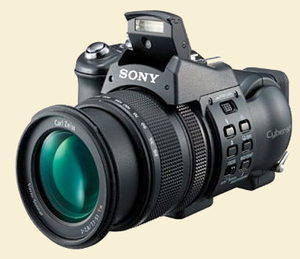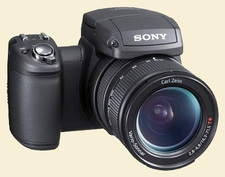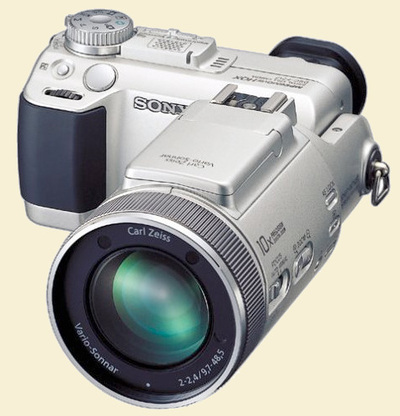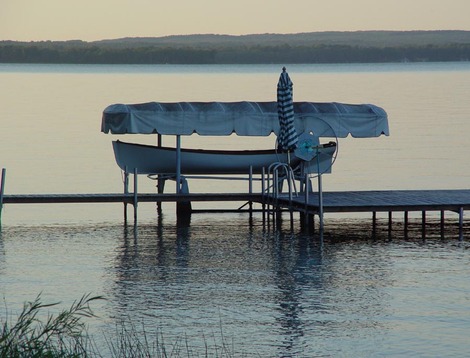Okay, so I only used the F-828 in the title because it rhymes with "late" and "great." The subject at hand is a whole series of related Sony cameras made between August of 1999 and roughly 2006. The series began with the F505, an odd-looking digicam that amounted to a hunky Zeiss zoom lens with a tiny articulating camera body sticking off to the side at one end. The series continued with the F707 two years later; the F717 a little more than a year after that, in September of '02; the strange-looking F828 (sometimes called the "dark angel" or "black angel" because of its color and swoopy excrescences) followed in August of 2003, and finally, at the very end of the "bridge camera" era, the relatively short-lived R1 of August 2005.
I owned an F707 for about a year when it was current. Its neatest trick was that it could photograph in the dark—it featured IR illumination built into the front of lens, which could be used either to set the focus distance and flash exposure, or to actually take an IR picture. The F717 was possibly the purest expression of the admittedly odd design, embodying as it did the furthest refinement of the original F505 concept.
 The redesigned F828 (right) added a new zoom lens that went wider (to 28mm-e) and had a number of new features, but, all in all, seemed to take the camera further than the tiny 2/3" sensor wanted to follow. Although the CCD sensor sported a number of innovations and improvements, including a fourth color photosite, 3 million more pixels, and a top sensitivity of ISO 800, real-world quality fell somewhat short of the theoretical. Although the camera was popular and many people liked theirs, its execution never quite rose to the level of its ambition.
The redesigned F828 (right) added a new zoom lens that went wider (to 28mm-e) and had a number of new features, but, all in all, seemed to take the camera further than the tiny 2/3" sensor wanted to follow. Although the CCD sensor sported a number of innovations and improvements, including a fourth color photosite, 3 million more pixels, and a top sensitivity of ISO 800, real-world quality fell somewhat short of the theoretical. Although the camera was popular and many people liked theirs, its execution never quite rose to the level of its ambition.
 The ill-fated R1, a brilliant camera in its own way, took the design much further by featuring a 10-MP, APS-C sensor. It departed from its immediate predecessors in important ways, however—it didn't have a "swiveling handle" body, and the articulated viewing screen was on the top of the lens. But it was the first non-SLR-type to feature a big APS-size sensor, and users report both excellent image quality and excellent usability features.
The ill-fated R1, a brilliant camera in its own way, took the design much further by featuring a 10-MP, APS-C sensor. It departed from its immediate predecessors in important ways, however—it didn't have a "swiveling handle" body, and the articulated viewing screen was on the top of the lens. But it was the first non-SLR-type to feature a big APS-size sensor, and users report both excellent image quality and excellent usability features.
Any of these could be used as "waist level" cameras, and their shutters were silent.
 A sad consequence of Sony's both-feet-first jump into the DSLR arena with the acquisition of Konica-Minolta's DSLR assets in 2006 was the company's abrupt loss of interest in the former top-of-the-line R1. Evidently sales had not been encouraging anyway. DSLRs were the up and coming market opportunity, so that's where the investment and the R&D efforts went. The R1 was forsaken and, with little fanfare, dropped.
A sad consequence of Sony's both-feet-first jump into the DSLR arena with the acquisition of Konica-Minolta's DSLR assets in 2006 was the company's abrupt loss of interest in the former top-of-the-line R1. Evidently sales had not been encouraging anyway. DSLRs were the up and coming market opportunity, so that's where the investment and the R&D efforts went. The R1 was forsaken and, with little fanfare, dropped.
Most cameras that make their way into the darkness of history are little noticed and less missed, but the F707 remains the most fun camera I've owned over the past twelve or so years, and the #1 most fun digital. Its only problem was its results—although image quality could be very pleasing under just the right conditions, it suffered from all the drawbacks of early sensors—limited DR, sometimes funky color, and loads of noise at modest ISOs.
It's too bad the species had to come to an end—I still sometimes muse quietly about a camera with a large sensor and the R1's lens, a swiveling body like the F707 and F717, and Super Steady Shot. I'd make the sensor square, too.
Such a beast might not be "practical," i.e., marketable, but it sure would be fun.
_____________________
Mike
Featured Comment by Peter F: "The passing of the great bridge cameras is something many fresh casual photographers would mourn if they understood what it meant. Known in my circle as 'the photography guy,' I'm routinely approached by friends who are 'thinking about buying a digital SLR' and want some guidance. They see everyone and their grandmother with one and figure that's what a camera needs to be. In some cases, I know a DSLR won't be their best bet, but the alternatives are a dying breed. I think the economics of the camera world (with entry-level DSLRs crowding out the high end bridge cameras) have done casual shooters a big disservice. Although on apples-to-apples terms no bridge camera has the power and flexibility of a DSLR, I firmly believe that the 'average' consumer is better served more than half of the time by a lightweight, compact, all-in-one solution. They will carry it more, so they will use it more. It's that simple. So when these friends ask me what camera they should get, I often find myself thinking of product lines and design philosophies that have died out thanks to the disconnect between what people think they want and what will actually serve them best (not, as is tragically showcased in certain contemporary democracies, always the same thing)."





Im with you 100% on this one. The F717 was my favorite digital -- that lens was just scary sharp. Add in the fact that the shutter is silent, you get infrared nightshot and the 200mm end of the lens still gives you f/2.8 and it was the perfect camera for shooting theatre.
That 90degree tilt lens also made it great for street work since again, it was silent and even if someone was looking at you, you could crank the lens out and act like you're just fiddling with the camera.
My only problem with it was the jpg algorithm threw really bad artifacts. Even blowing up a full-res image to 11x14 would show it. Shooting in TIFF didn't help, oddly enough.
Posted by: Clint | Wednesday, 04 June 2008 at 01:34 PM
I still use the '717 - still my favorite walk in the park/flower camera.
Is this a Sony-only lament? We have some nice cameras from Fuji and Panasonic that do similar functions.
One one hand I think the feeling of the manufacturers is that the swivel screens of the new DSLRs and a 28-200 (equiv) lens kind of take care of this issue - albeit at a cost of size and 1-2 f/stops?
On the other - Nikon makes no real equivalent to the 8xxx series nor did Canon produce a successor to the Pro1.
Sorry for the ramble...
Posted by: Jason | Wednesday, 04 June 2008 at 02:31 PM
Dear MIke,
I bought several of the R1's when they seemed destined to be discontinued and I adore them. I've used them in many professional assignments and find they are perfect for tabletop and architecture. The lens has very little distortion and it bitingly sharp. My only quibble is the slow autofocus under low light. For anyone who takes the time to learn the R1. Really learn the R1! The rewards are endless. I'd sooner loose my D300 than either of my Sony's.
Best, Kirk
Posted by: kirk tuck | Wednesday, 04 June 2008 at 02:51 PM
Well . . . MY R1 was way too heavy and clunky.
I sold it back to B&H and got an Olympus E-510. Much more svelte and more all-around versatile.
Posted by: Mike Mundy | Wednesday, 04 June 2008 at 03:23 PM
The R1 was a great concept that was arguably before it's time. Too bad that there were too many niggles in the execution to make it truly stellar.
Posted by: Peter | Wednesday, 04 June 2008 at 03:42 PM
An 'R2' with interchangeable lenses and a few technical improvements would blow away most 'prosumer' SLRs. My personal prejudice is that most photographers are convinced that since the best film cameras were SLRs, the best digital cameral must also be SLRs. Ain't necessarily so.
Posted by: Rich Sajdak | Wednesday, 04 June 2008 at 03:56 PM
The R1 is a member of a very exclusive club, along with the Sigma DP-1, the Epson RD-1, and Leica's M8. The name of the club, if anyone hasn't figured it out by now, is "non-SLRs with relatively big sensors". Did I miss any?
I haven't owned any of these cameras, but some day I would very much like to use a non-DSLR large-sensor digital camera.
Posted by: Ben Rosengart | Wednesday, 04 June 2008 at 03:57 PM
With the demise of Minolta and integration into Sony, a similar fate awaited the Minolta A2, which must be the closest that digital ever came to the "persona" of a Barnack Leica.
Just a tiny bit of tweaking of the lens and an updated (same-size) sensor would have made it virtually a perfect camera for the generalist photographer.
But nobody asked me!
Posted by: Bill Mitchell | Wednesday, 04 June 2008 at 04:05 PM
And for someone who gets lovely results out of these cameras, may I recommend Pascal Renoux. There are nudes in the series for those who would want to know that before clicking on the link.
http://www.pascalrenoux.com/
Posted by: David Bennett | Wednesday, 04 June 2008 at 04:10 PM
Last year, I found an F707 my newspaper had stashed away in a cardboard box on a shelf in the computer lab. I tested it and put it back into circulation for reporters. For the few who took the time to learn how to use it, it is far and away their favorite digicam of the many they have to pick from. It was SO far ahead of its time.
Posted by: Terry Manning | Wednesday, 04 June 2008 at 07:53 PM
I have a KM A2 and wouldn't part with it, but four years on, the noise is now a bit high compared to my G9. But can I claim a new member of the club mentioned above? The Fujifilm S100fs. I've just bought one as a do-all travel camera for a 2 month long round world trip. The sensor is a 2/3" Super CCD, bigger than the usual tiny chips and features the Fuji dual photosites for highlight retention. The fs stands for Film Simulation. Since I like the Velvia look, it suits me. The LCD swings out from the body and can be used as a waist level finder, like the Sony R1. Feels good so far. See the DPReview review. And for once, praise be, the Aussie price was $760, roughly equal to the USA price.
Finally, if anyone still lusts after a Sony R1, I happened to notice recently that a white goods retailer in my town, Perth, West Australia, (who also sells computers and the full range of Sony) still has two R1s in his cabinets. Different cabinets, different prices (!), but one was A$938 and the other about A$960 I think. Anyone want to buy a new R1? Email me.
Pete (pjcroft-at-virginbroadbanddotcomdotau)
Posted by: Peter Croft | Wednesday, 04 June 2008 at 10:21 PM
The F717 was my pre-DSLR camera. (Had a 1MP Kodak before that that produces poor 4x6" prints). For all the hand-wringing on the Minolta forums that went on because Sony was taking over the DSLR line, I have to say that I never had to open the owners manual for that F717 once. The zoom ring ... nice (and you could program it to zoom W-T or T-W). Of course, you could push button zoom if you're so inclined. And you could use that same ring for manual focus. The swivel body was brilliant.
Since getting a DSLR, I haven't used it to speak of - except to take out on the beach when I didn't want to expose my DSLR to the elements. It's not compact enough to ever want to carry instead of a DSLR (though the lens has great range). AF was slow, shutter lag was slow - half-press was essential to do much of anything with it. I have a couple of 128MB Memory Sticks that hold all of about 60 pictures each on high quality setting. But to this day, pictures from that camera somehow seem nicer in some way than those from my Canon A610 (which is also 5MP, but a slightly smaller sensor). Maybe it's the f/2 lens, I don't know. I let my now-5-year-old daughter try it and she decided it's hers :)
Posted by: Dennis | Wednesday, 04 June 2008 at 11:22 PM
You left off the F505V which I own, it improved on the F505. I still have both these cameras along with a F707 and the F828. I don't use them very often anymore, but they are still my favorite cameras, particularly the 828, which was the only one to take 640 X 480 movies.
Posted by: Joel Schilling | Thursday, 05 June 2008 at 12:19 AM
I still own and use my 828. It's by far my favorite digital, and maybe my all-time favorite camera. (The other contender, go figure, is my Deardorff.)
I've owned two DSLR systems since I bought the 828, but the Sony is still my favorite to use, provided the light is good and the subject will stand still.
If Sony had continued this line (or even the R-1) I might never have bothered with DSLRs.
Posted by: JR Sprawls | Thursday, 05 June 2008 at 10:10 AM
What a pleasant dream, Mike! A camera with an R1 lens and a swiveling body and like the 828. Add Sony's Steady Shot, the R1's thumbwheel exposure compensation, and selectable vertical and horizontal cropping on a 6cm-square LCD. Sweet!
Posted by: Joe Dasbach | Thursday, 05 June 2008 at 08:34 PM
Mike,
After a disapointing period with a Nikon 990, I was backing away from digital until I found the 707. It felt comfortable in the hand, and was actually fun to use with the body tilted up like a waist level viewfinder. And the shutter lag wasn't near as noticable. The 707 is now converted to IR, and my 717 still gets a lot of use. I found that even when I had my Canon 20D, the 717 was the one that got carried everywhere. And as they say, the best camera is the one you have with you!
Posted by: Roger Engle | Thursday, 05 June 2008 at 11:50 PM
My mom owns a 707, now almost seven years old, and it was also the camera I used when I started to take photography seriously. It's pretty wonderful, has a good feel, and a highly useful set of features, many of which are left off of non-SLR cameras these days due to the changes in pricing. Yes, it's got its flaws (ISO 200 is quite visibly noisy, and it produces some quite odd color shifts) but if you give it the right scene it's fantastic! And the big lens and swivel back... I loved it.
Posted by: Andrew Rodland | Saturday, 07 June 2008 at 12:47 AM
Oh yes, the 707's other major limitation (not shared with the 717 or the 828)... it's only compatible with Sony's original Memory Stick format, meaning it can't handle cards larger than 128MB. Even with the 707's comparatively small JPEGs, an eighth of a gig gets cramped.
Posted by: Andrew Rodland | Saturday, 07 June 2008 at 12:51 AM
Very nice post, brings back some nice camera related memories. :) Sony's were my first (digi)cams, started to take photos with them.
I have had F505V, F717, F828 and R1. Still own the latter two and thinking about buying the first ones also, if I see them somewhere for sale... for old times sake. ;) Great cameras!
My F828 doesn't get much of a use nowadays, but I still use R1 for various occasions, for example strobist stuff... my D300 can't sync at high +1/1000 speeds with normal non-Nikon flashes, R1 does the job. :) And it's silent so I use it when photoing funerals & weddings etc..
Very nice camera, if they had made a "R2" with some improvements I also might never(?) bought a dslr..
- Hans
Posted by: H.L. | Saturday, 07 June 2008 at 04:20 AM
Great post, Mike. I love my R1 and have taken it everywhere in my travels. My favorite use for it is from a small airplane, where I can reach across the cockpit and shoot aerials at arm's length from any window, something that would be impossible without the digicam feature of a DSLR. Also excellent for portraiture work in waist level viewfinder configuration.
Posted by: Lori | Saturday, 07 June 2008 at 12:40 PM
Also a shame that Sony didn't follow up on the DSC-V3, a camera which was in many ways superior to its Canon peer, the Powershot G6. Sony was on the right track with two lines of advanced non-SLR cameras and seems to have sacked both of them.
Posted by: amin | Tuesday, 10 June 2008 at 01:28 PM